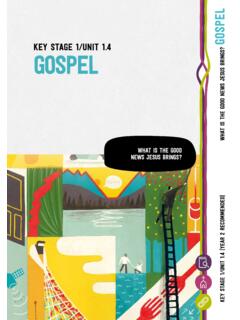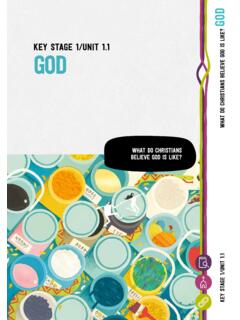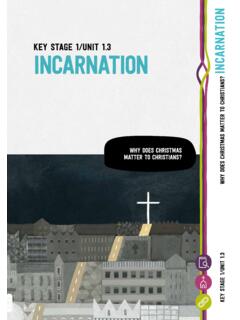Transcription of KEY STAGE 1/UNIT 1.5 SALVATION - Understanding Christianity
1 Why does Easter matter to Christians?Why does Easter matter to Christians? SalvationKEY STAGE 1/UNIT STAGE 1/UNIT does Easter matter to Christians? OUTCOMESBY THE END OF THIS UNIT, PUPILS ARE EXPECTED TO BE ABLE TO: Recognise that Incarnation and SALVATION are part of a big story of the Bible. Tell stories of Holy Week and Easter from the Bible and recognise a link with the idea of SALVATION (Jesus rescuing people). Recognise that Jesus gives instructions about how to behave. Give at least three examples of how Christians show their beliefs about Jesus death and resurrection in church worship at Easter. Think, talk and ask questions about whether the story of Easter has anything to say to them about sadness, hope or heaven, exploring different ideas. YOU MIGHT LIKE TO START a walk in springtime to look at signs of both Easter and new life. This is a good time of year to visit farms and see the new arrivals.
2 CORE LEARNING KNOWLEDGE BUILDING BLOCKSPUPILS WILL KNOW THAT: Easter is very important in the big story of the Bible. Christians believe Jesus rose again, giving people hope of a new life. MAKe SENSE of the text UNDERSTAND the impact MAKe CONNECTIONS Select and weave together activities to achieve the outcomes OUTCOMES This unit will probably be taught in the second half of the Spring Term. If so, discuss what our senses tell us about springtime, how spring differs from the other seasons, including the idea of new life. What signs tell us that Easter is approaching? Ask pupils why they think Easter is important to Christians. Collect their responses at this STAGE . Explain that Easter is a festival that occurs in spring to remember a very important part of the Bible. Remind pupils that Christians celebrate the birth of Jesus at Christmas. Christians believe that Jesus is God come to earth .
3 The life of Jesus and many things he said and did are found in the Gospels in the Bible. The Easter story is one of sadness, followed by great happiness. Set up an Easter labyrinth for pupils. Essential parts of the story to be included in the labyrinth for Year 1 are: 1) The entry into Jerusalem; 2) Jesus betrayal and arrest at the Mount of Olives; 3) Jesus crucifixion; 4) The empty tomb; 5) Jesus appearance to Mary Magdalene and the disciples. Biblical references are in the teacher s notes, but ensure that these extracts are told in a child-friendly manner. At each stop on the labyrinth, pupils should hear part of the story and have a chance to discuss and reflect on it, expressing their thoughts, feelings and questions. At this age, it is useful to make the labyrinth as sensory as possible: for example, have palm leaves to feel (and wave) for the entry into Jerusalem, and vinegar to smell for the crucifixion.
4 Play Easter pass the parcel . Under each layer should be a picture or caption from the Easter story (have them in order, so the entry to Jerusalem is on the outermost layer). As each picture/caption is revealed, the pupil who opened it should retell that part of the story, with the other players checking for accuracy. (See Resource Sheet 1.) Have some small Easter eggs as the prize in the middle of the Easter pass the parcel. Ask pupils why eggs are connected to Easter. If necessary remind pupils of their walk and discussion focusing on new life, explaining (if you haven t already) why eggs are a symbol of new life. Are pupils able to spot a part of the story that is about new life? Place the events of Easter on the Big Story of the Bible timeline, using the frieze artwork and the keywords (Incarnation, Gospel, SALVATION see Essential Information). Ask pupils again, why does Easter matter to Christians?
5 How have their answers changed?MAKING SENSE OF THE TEXTNOTE: Teachers should read the Essential Information pages before teaching this : You can use this unit for Year 1 or Year 2. If you teach Easter to every year group, the Core Learning section is suitable for Year 1 and Digging Deeper is suitable for Year Ask pupils why people find it helpful to believe that there is a heaven. Make a link with the idea for Christians that Jesus brings good news. Give pupils time to reflect on the way the story changes from sadness to happiness, or from darkness to light. Give them a chance to paint some dark marks on a page, perhaps listening to some quiet music, then to paint some bright colours, with joyous music accompanying. Ask them to talk about what it might feel like when something good happens after something sad. Discuss what pupils find happy and sad about the story of Easter.
6 Looking at a colour chart, discuss which colours pupils think are happy and which they think are sad. Pupils place template of crosses onto a plain piece of white paper. Smudge around outside with oil pastels so when template is lifted off there s a blank cross surrounded by colour. Each pupil should make a cross in happy colours and a cross in sad colours . The first should be filled with parts of the story that make pupils feel happy, and the second with parts that make them feel sad. Discuss some other emotions; for example, angry, excited, surprised, worried, scared. Pupils show these on their faces and bodies and talk about times when they feel each one. Show pictures of the five parts of the story included in the labyrinth. Can pupils match at least one emotion to each part of the story? Happy and sad can also be used as part of this emotion-matching CONNECTIONSMAKING CONNECTIONS Show pupils a hot cross bun and ask them to identify how it is different from a currant bun, and how it is linked to the Easter story.
7 Explain that many Christians eat hot cross buns at Easter to remind them of the Easter story. Invite in a member of the clergy or a local Christian to share some images, objects and experiences linked to ways in which Christians remember the story of Holy Week and Easter. Introduce pupils to traditions linked with Palm Sunday (palm cross, Palm Sunday processions, for example), Good Friday (for example, special church service at 3 o clock, eating hot cross buns, visiting the stations of the cross ) and Easter Sunday (for example, a joyful church service in the morning, giving and eating eggs, decorating a cross in church). Help pupils to remember how each practice links to the story by putting on one classroom wall a picture of Jesus riding into Jerusalem, three crosses on a second wall, and the empty tomb on the third. Give pupils one of the Easter practices they have learnt about they should run to the picture it links to.
8 Pupils should justify their choices. Look at pictures of decorated Easter eggs, not chocolate ones. Remind pupils why eggs are used as symbols at Easter due to their links with new life. Make a papier m ch egg and decorate it with pictures of what Christians do at Easter. Stick a small cardboard cross onto the egg. Create some simple actions that pupils can copy to show the events of Holy Week, from the perspective of a disciple: Palm Sunday (waving palms, excited), Good Friday (sad, show tears coming down cheeks), Easter Sunday (excited, happy, dancing, as Jesus rises to new life) this is how the story ends! Talk about the Christian belief that Jesus rises from his tomb (resurrection) and even appears and speaks to people that he used to know. Explain that Jesus rising from his tomb shows Christians that after they die, they can also have a new life, a life with God in heaven.
9 Read together the start of Heaven by Nicholas Allen, and discuss both Lil and Dill s ideas. Ask pupils what they think heaven might be like can they describe it with words or draw images? Listen to Waterbugs and Dragonflies by Doris Stickney. Discuss where the dragonfly went and how this makes him feel. Ask pupils whether this is a happy or sad tale. What links can they see with the story of Jesus and his resurrection? What is different about the story of Jesus? Talk with pupils about the fact that beliefs in life after death vary. Christians believe that if you trust God, there is another life after this life, in heaven with God. Christians think Jesus showed that there is life after death by coming alive again after he was killed on the cross at the first Easter. Christians believe Jesus was able to come back to tell his disciples, because he was God in the flesh (incarnation).
10 No one knows exactly what heaven is like, but Christians at a funeral say there will be no tears there, and people who know God will find peace and rest. Understanding THE IMPACT3 Copyright RE Today Services 2016, used under licence. KNOWLEDGE BUILDING BLOCKSPUPILS WILL KNOW THAT: Easter is very important in the big story of the Bible. Jesus showed that he was willing to forgive all people, even for putting him on the cross. Christians believe Jesus builds a bridge between God and humans. Christians believe Jesus rose again, giving people hope of a new life. OUTCOMESBY THE END OF THIS UNIT, PUPILS ARE EXPECTED TO BE ABLE TO: Recognise that God, Incarnation, Gospel and SALVATION are part of the big story of the Bible. Tell stories of Holy Week and Easter and make a link with the idea of SALVATION (Jesus rescuing people). Give at least three examples of how Christians show their beliefs about Jesus as saviour in church worship.


